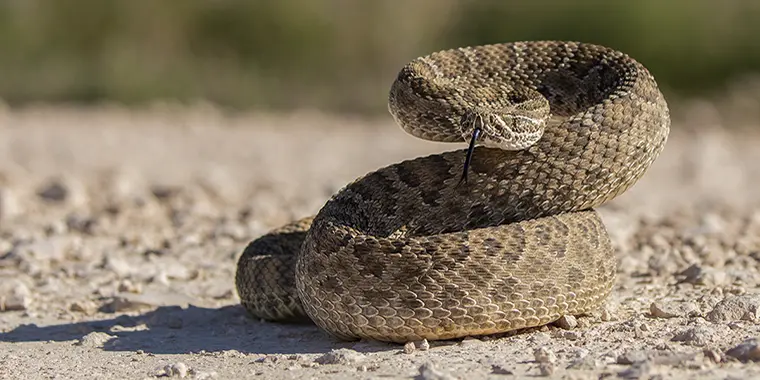
The following is a guest post by Carl Person. Carl and his team have trained all my dogs, and I highly recommend you also send your dog through rattlesnake training. It’s a 15-30 minute process. Repeat it every 1-2 years.
Carl Person has worked with venomous snakes since 1979. He has a B.S. in Biology and is finishing his Ph.D. at Loma Linda University on rattlesnake biology and behavior. On to Carl …
With the arrival of spring, we love to be outdoors and take our pets with us to explore and enjoy the beauty of nature. Southern California’s trails and parks offer various habitats, from low deserts to high alpine forests. Daily, people and their pet companions converge on these sites in droves. The exhilaration of being in these pristine outdoor environments often makes us forget that, within these treasured getaways, there is potential for disaster.
Rattlesnake Season
Rattlesnakes also come out in the springtime to begin their endless search for food. In Southern California, we find six different species of rattlesnakes: The Southern Pacific, Red Diamond, Mohave, Southwestern Speckled, Sidewinder, and Western Diamondback. Though on the food list of many predators, rattlesnakes are almost perfectly designed hunters. Rattlesnakes are a pit-viper and have a highly-sensitive, infrared-sensing pit between the eye and the nostril. This organ gives the snake a three-dimensional infrared image of its surroundings and the ability to see very well at night—even in the forest under the darkest conditions. It’s a huge advantage when hunting warm-blooded prey.
Rattlesnake Venom
Pit vipers also have long fangs folded up against the roof of their mouth. They are rotated ninety degrees forward, delivering a large amount of venom deep into their victim. The venom is of great advantage to the snake. After they bite, they can immediately release their prey, preventing the snake from being scratched, bitten, or harmed by their food source. The venom also provides a tracking tag. The long, forked tongue snakes flick in and out is part of an extremely sensitive chemosensory system by which snakes can track the scent of their victims. So, the venom is designed first to immobilize the prey, then kill it, and finally, provide tracking; venom is primarily a way of getting food—defense is secondary.
The venom of rattlesnakes varies from species to species and even between different populations of the same species. A good example of this is the Southern Pacific Rattlesnake. Southern Pacific Rattlesnakes are found from the low desert areas in the eastern Coachella Valley to mountain habitats above 10,000 feet; they can also be found on beaches, low rolling hills, and Santa Catalina Island. Because they exploit such a wide variety of habitats, their prey items also vary widely, influencing the venom diversity in this species. On Mt. San Jacinto, the snake population has a powerful presynaptic neurotoxin. Snakes at the base of the mountain lack this element but have a rich mixture of small myotoxins and myoneurotoxins. This variation in the venom profiles makes this species the most medically significant snake in Southern California.
Rattlesnake Bites
Avoiding snake bites is on the minds of many as they plan their retreats in rattlesnake country. There are measures you can take to reduce your risk. The first thing to remember is that the snake wants nothing to do with you. It hopes to avoid you as much, if not more, than you do! With this in mind, if you see a snake, take two steps back, and you will be out of striking range and safe.
Stop, locate the animal, and back away if you hear a rattlesnake. Be sure to stay on the open trails and, if crossing over a rock or log, step on top of it first and check on the other side. Avoid putting your hands into areas where you cannot see what’s there. A good set of hiking boots and long pants are helpful, but their fangs can penetrate both, which will help reduce the amount of venom delivered.
If you or your pet get bitten, it is important to remember a few things:
- DO NOT panic! There is typically plenty of time to get to a hospital or veterinarian. Adults and medium to large dogs will usually have enough time to get treatment. However, for children and small dogs, time is limited.
- DO NOT try to capture or kill the snake for identification. In California, the available antivenom covers all types of rattlesnakes.
- DO NOT use tourniquets, ice, cutting, or any of the commonly marketed “Snake Bite Kits”! These actions will make things much worse for you or your pet! Dialing 911 is the only thing you should do for a bite to a human!
The Solution to Pollution is Dilution.
– Dr. Sherry A. Rodgers, MD - Antivenom is the only treatment that works. Even if your pet has received the rattlesnake vaccine, it must have emergency treatment!
- DO NOT attempt to drive yourself – there is a high risk of passing out due to a drop in blood pressure!
- Remove any jewelry near the bitten area; as the swelling begins, these items become a restriction device that can lead to losing a finger or, perhaps, your hand.
- Remain still while waiting for an ambulance. If your dog has been bitten, it’s best to carry it to your car.
- Keep the bite site at heart level if possible. Unfortunately, the majority of bites that dogs receive are on the face while investigating the snake. This type of bite will adversely affect the dog’s ability to breathe, so the immediate administration of Benadryl and professional medical attention is needed.
- Benadryl will help reduce inflammation and help reduce the risk of an allergic reaction (recommended dosage for dogs is 1mg/lb. – consult with your veterinarian)
- Limit liquid intake because the body pumps fluids to the bite site, increasing painful swelling. If available, chew on ice to relieve thirst. Avoid alcohol; it thins your blood, as does the venom.
Rattlesnake Vaccine
I am often asked if the rattlesnake vaccine offered for horses and dogs will help. The simple fact is that if it helps, it is very minimal and probably not at all after thirty days. The vaccine is made only with Western Diamondback venom, which has a very different venom profile than most other species, especially the Southern Pacific Rattlesnake. You STILL have to get emergency treatment for your pet. If vaccines for snake bites worked the way we wished, there would be no need for antivenom. The best method for preventing disaster is to have your dog trained to avoid snakes in the first place. Not only are they very quick to learn this behavior, but they also become your early warning system!
Schedule your Rattlesnake Training at Animalia Herpetofauna.
Play the Audio





